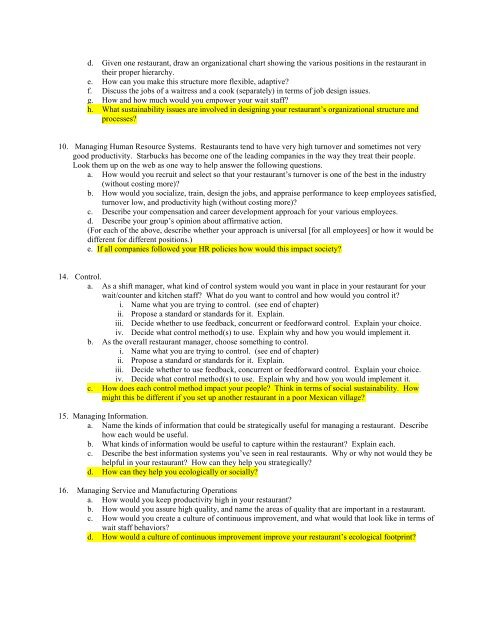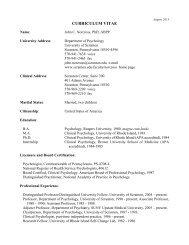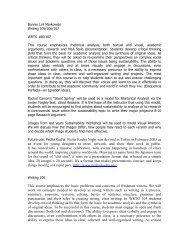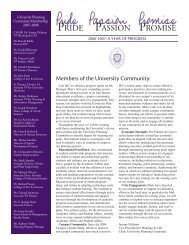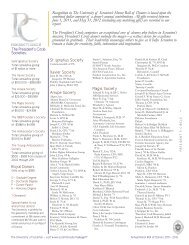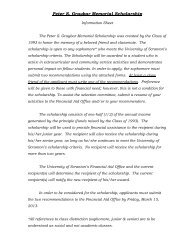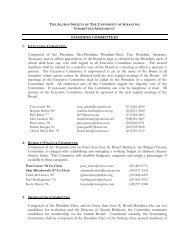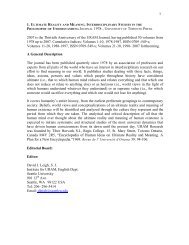MGT 351 - The University of Scranton
MGT 351 - The University of Scranton
MGT 351 - The University of Scranton
You also want an ePaper? Increase the reach of your titles
YUMPU automatically turns print PDFs into web optimized ePapers that Google loves.
d. Given one restaurant, draw an organizational chart showing the various positions in the restaurant in<br />
their proper hierarchy.<br />
e. How can you make this structure more flexible, adaptive?<br />
f. Discuss the jobs <strong>of</strong> a waitress and a cook (separately) in terms <strong>of</strong> job design issues.<br />
g. How and how much would you empower your wait staff?<br />
h. What sustainability issues are involved in designing your restaurant’s organizational structure and<br />
processes?<br />
10. Managing Human Resource Systems. Restaurants tend to have very high turnover and sometimes not very<br />
good productivity. Starbucks has become one <strong>of</strong> the leading companies in the way they treat their people.<br />
Look them up on the web as one way to help answer the following questions.<br />
a. How would you recruit and select so that your restaurant’s turnover is one <strong>of</strong> the best in the industry<br />
(without costing more)?<br />
b. How would you socialize, train, design the jobs, and appraise performance to keep employees satisfied,<br />
turnover low, and productivity high (without costing more)?<br />
c. Describe your compensation and career development approach for your various employees.<br />
d. Describe your group’s opinion about affirmative action.<br />
(For each <strong>of</strong> the above, describe whether your approach is universal [for all employees] or how it would be<br />
different for different positions.)<br />
e. If all companies followed your HR policies how would this impact society?<br />
14. Control.<br />
a. As a shift manager, what kind <strong>of</strong> control system would you want in place in your restaurant for your<br />
wait/counter and kitchen staff? What do you want to control and how would you control it?<br />
i. Name what you are trying to control. (see end <strong>of</strong> chapter)<br />
ii. Propose a standard or standards for it. Explain.<br />
iii. Decide whether to use feedback, concurrent or feedforward control. Explain your choice.<br />
iv. Decide what control method(s) to use. Explain why and how you would implement it.<br />
b. As the overall restaurant manager, choose something to control.<br />
i. Name what you are trying to control. (see end <strong>of</strong> chapter)<br />
ii. Propose a standard or standards for it. Explain.<br />
iii. Decide whether to use feedback, concurrent or feedforward control. Explain your choice.<br />
iv. Decide what control method(s) to use. Explain why and how you would implement it.<br />
c. How does each control method impact your people? Think in terms <strong>of</strong> social sustainability. How<br />
might this be different if you set up another restaurant in a poor Mexican village?<br />
15. Managing Information.<br />
a. Name the kinds <strong>of</strong> information that could be strategically useful for managing a restaurant. Describe<br />
how each would be useful.<br />
b. What kinds <strong>of</strong> information would be useful to capture within the restaurant? Explain each.<br />
c. Describe the best information systems you’ve seen in real restaurants. Why or why not would they be<br />
helpful in your restaurant? How can they help you strategically?<br />
d. How can they help you ecologically or socially?<br />
16. Managing Service and Manufacturing Operations<br />
a. How would you keep productivity high in your restaurant?<br />
b. How would you assure high quality, and name the areas <strong>of</strong> quality that are important in a restaurant.<br />
c. How would you create a culture <strong>of</strong> continuous improvement, and what would that look like in terms <strong>of</strong><br />
wait staff behaviors?<br />
d. How would a culture <strong>of</strong> continuous improvement improve your restaurant’s ecological footprint?


